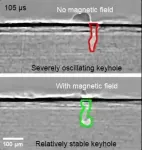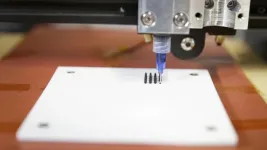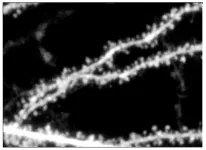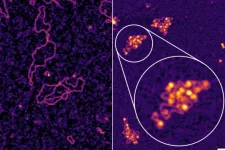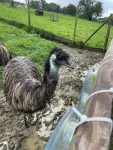(Press-News.org) Inspired by the cooperation of cells in tissues, researchers have developed a robotic collective system capable of transitioning between rigid and solid structures that can also support hundreds of times its own weight. The advancement overcomes a core challenge in the development of so-called “robotic materials” – cohesive networks of individual robotic units that function as a single dynamic, adaptive structure. Realizing these systems presents a fundamental challenge: this “material” must at once be strong and stiff enough to support loads, yet at the flip of a switch, be able to flow freely to take new forms. Unlike inert materials and conventional robotic systems, living embryonic tissues possess the remarkable ability to internally regulate their mechanical properties across space and time. Drawing inspiration from living embryonic tissues, which regulate mechanical properties through coordinated cellular behavior, Matthew Devlin and colleagues engineered robotic collectives that mimic key cell-cell interaction mechanisms using motorized gears, photoreceptors, and rolling magnets. These features enable precise control over force fluctuations and polarity, allowing the system to dynamically adjust rigidity and fluidity. Devlin et al. demonstrated structure formation, with robotic units forming pillars that merged into a stable, load-bearing arch. The collective also exhibited self-healing, fluidizing to close structural defects. And it exhibited object manipulation, applying directed forces to move items. Additionally, the system adapted into functional tools, flowing around objects before rigidifying into a wrench capable of exerting torque. The researchers further showcased supporting structures, where the collective bore loads exceeded individual unit weight – supporting a human (~700 Newtons) before effortlessly transitioning back into a fluid state.
END
Bioinspired robot collectives that can act like solids or fluids on demand
Summary author: Walter Beckwith
2025-02-20
ELSE PRESS RELEASES FROM THIS DATE:
AI-assisted diagnosis for immunological disease
2025-02-20
A novel machine learning framework – Mal-ID – can decipher an individual’s immune system’s record of past infections and diseases, according to a new study, providing a powerful tool with the potential for diagnosing autoimmune disorders, viral infections, and vaccine responses with precision. Traditional clinical diagnostic methods for autoimmune diseases or other immunological pathologies tend to rely on a combination of physical examination, patient history, and various laboratory testing for cellular or molecular abnormalities – a lengthy process often complicated by initial misdiagnoses and ambiguous systems. These approaches make limited use of data from ...
A new approach for breaking plastic waste down to monomers
2025-02-20
Researchers have reported a method for breaking down commercial polymers like Plexiglass into monomers, a form more desirable for reuse. This could help alleviate the growing plastic waste stream. Most current plastic recycling methods rely on macroscopic mechanical shredding, cleaning and reprocessing. As a result, the properties degrade relative to the virgin polymer. Chemical decomposition to the original monomer would enable more thorough purification and then repolymerization to restore ideal performance. Here, Hyun Suk Wang and colleagues report the discovery that in dichlorobenzene solvent, violet light irradiation ...
High-performance computing at a crossroads
2025-02-20
High-performance computing (HPC) systems – advanced computing ensembles that harness deliver massive processing power – are used for a range of applications, and the demand for them has increased with the rise of generative artificial intelligence (AI). However, for both traditional uses and to advance the power of AI, technical advances in HPC are greatly needed, say Ewa Deelman and colleagues in a Policy Forum. “With international competition for leadership in computing intensifying, without a renewed commitment, ...
Chemists find greener path to making key industrial chemical
2025-02-20
Scientists have discovered a potentially greener way to produce a crucial industrial chemical used to make many everyday products from plastics and textiles to antifreeze and disinfectants, according to a new study published in Science and co-authored by Tulane University chemical engineer Matthew Montemore.
The breakthrough could significantly reduce greenhouse gas emissions from the manufacture of ethylene oxide, which has an estimated $40 billion global market. The current production process requires chlorine, which is toxic and ...
Giant X-ray facility shows that magnets can reduce flaws in 3D printed components
2025-02-20
Safety critical components for aircraft and Formula 1 racing cars could one day be 3D printed via a new technique, developed by researchers at UCL and the University of Greenwich, that substantially reduces imperfections in the manufacturing process.
The technique was developed after the team used advanced X-ray imaging to observe the causes of imperfections that formed in complex 3D printed metal alloy components. If this technique becomes widely deployed it could make a range of these components, from artificial hip joints to aircraft parts, stronger and more durable.
The study, published in Science, observes the forces at play during ...
Cooling materials – Out of the 3D printer
2025-02-20
Rapid, localized heat management is essential for electronic devices and could have applications ranging from wearable materials to burn treatment. While so-called thermoelectric materials convert temperature differences to electrical voltage and vice versa, their efficiency is often limited, and their production is costly and wasteful. In a new paper published in Science, researchers from the Institute of Science and Technology Austria (ISTA) used a 3D printing technique to fabricate high-performance thermoelectric materials, reducing production costs significantly.
Thermoelectric coolers, also called solid-state ...
New knowledge portal adiposetissue.org enhances obesity and metabolism research with centralized data
2025-02-20
Addressing the Challenge of Dispersed Data
For years, adipose tissue research has generated vast amounts of omics data, but these datasets remained scattered across different repositories, making comprehensive analysis challenging. Adiposetissue.org now brings insights together, integrating transcriptomic and proteomic with clinical data from more than 6,000 individuals, enabling researchers to explore obesity-related changes, weight-loss effects, and cellular mechanisms with unprecedented depth.
“We developed ...
Study suggests new molecular strategy for treating fragile X syndrome
2025-02-20
Building on more than two decades of research, a study by MIT neuroscientists at The Picower Institute for Learning and Memory reports a new way to treat pathology and symptoms of fragile X syndrome, the most common genetically-caused autism spectrum disorder. The team showed that augmenting a novel type of neurotransmitter signaling reduced hallmarks of fragile X in mouse models of the disorder.
The new approach described in Cell Reports works by targeting a specific molecular subunit of “NMDA” receptors that they discovered plays a key role in how neurons synthesize ...
Digging into a decades-old hepatitis B mystery suggests a new potential treatment
2025-02-20
In their effort to answer a decades-old biological question about how the hepatitis B virus (HBV) is able to establish infection of liver cells, research led by Memorial Sloan Kettering Cancer Center (MSK), Weill Cornell Medicine, and The Rockefeller University identified a vulnerability that opens the door to new treatments.
The team successfully disrupted the virus’s ability to infect human liver cells in the laboratory using a compound already in clinical trials against cancer — laying the ...
Big birds like emus are technical innovators, according to University of Bristol researchers
2025-02-20
Large birds – our closest relations to dinosaurs - are capable of technical innovation, by solving a physical task to gain access to food.
This is the first time scientists have been able to show that palaeognath birds such as emus and rheas can solve tricky problems.
In the study, published today in Scientific Reports, emus, which have previously been called the ‘world’s dumbest bird’ were able to create one new technique to access food (lining up a hole with a food chamber) and moved the hole in the most efficient direction towards food in 90% of cases. A male rhea ...
LAST 30 PRESS RELEASES:
University of Oklahoma researcher awarded funding to pursue AI-powered material design
Exploring how the visual system recovers following injury
Support for parents with infants at pediatric check-ups leads to better reading and math skills in elementary school
Kids’ behavioral health is a growing share of family health costs
Day & night: Cancer disrupts the brain’s natural rhythm
COVID-19 vaccination significantly reduces risk to pregnant women and baby
The role of vaccination in maternal and perinatal outcomes associated with COVID-19 in pregnancy
Mayo Clinic smartwatch system helps parents shorten and defuse children's severe tantrums early
Behavioral health spending spikes to 40% of all children’s health expenditures, nearly doubling in a decade
Digital cognitive behavioral treatment for generalized anxiety disorder
Expenditures for pediatric behavioral health care over time and estimated family financial burden
Air conditioning in nursing homes and mortality during extreme heat
The Alps to lose a record number of glaciers in the next decade
What makes a good proton conductor?
New science reporting guide published for journalists in Bulgaria
New international study reveals major survival gaps among children with cancer
New science reporting guide published for journalists in Turkey
Scientists develop a smarter mRNA therapy that knows which cells to target
Neuroanatomy-informed brain–machine hybrid intelligence for robust acoustic target detection
Eight SwRI hydrogen projects funded by ENERGYWERX
The Lundquist Institute and its start-up company Vitalex Biosciences Announces Strategic Advancement of Second-Generation fungal Vaccine VXV-01 through Phase 1 Trials under $40 Million Competitive Con
Fine particles in pollution are associated with early signs of autoimmune disease
Review article | Towards a Global Ground-Based Earth Observatory (GGBEO): Leveraging existing systems and networks
Penn and UMich create world’s smallest programmable, autonomous robots
Cleveland researchers launch first major study to address ‘hidden performance killer’ in athletes
To connect across politics, try saying what you oppose
Modulating key interaction prevents virus from entering cells
Project explores barriers to NHS career progression facing international medical graduates
Jeonbuk National University researchers explore the impact of different seasonings on the flavor perception of Doenjang soup
Two Keck Medicine of USC Hospitals named Leapfrog Top Teaching Hospitals
[Press-News.org] Bioinspired robot collectives that can act like solids or fluids on demandSummary author: Walter Beckwith
